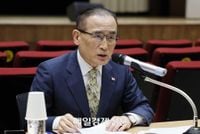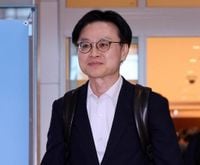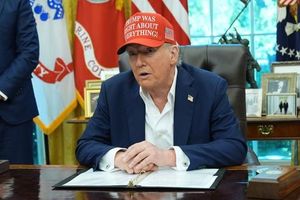South Korean President Lee Jae Myung has embarked on a whirlwind diplomatic tour that underscores the shifting dynamics in Northeast Asia, with high-stakes summits in Japan and the United States setting the stage for a new era of regional cooperation—and tension. On August 23, 2025, Lee touched down in Tokyo for his first formal meeting with Japanese Prime Minister Shigeru Ishiba, a move widely interpreted as a significant gesture toward healing old wounds and forging stronger ties between the two neighbors. The meeting, which coincided with the 60th anniversary of the normalization of diplomatic relations between Seoul and Tokyo, produced the first joint statement between the countries in 17 years. In it, the leaders pledged to work together on international challenges, emphasizing the importance of future-oriented and mutually beneficial cooperation.
Prime Minister Ishiba praised Lee’s decision to make Japan his first overseas destination before heading to the United States, calling it a “significant diplomatic gesture” not seen since the two countries normalized ties in 1965, according to Japantoday. The summit’s agenda was packed: North Korea’s nuclear ambitions, the rise of China, and domestic issues such as declining birth rates—all pressing concerns for both governments. But perhaps most notably, the two leaders sought to move past the shadow of Japan’s 1910-1945 colonial rule of Korea, which has long complicated bilateral relations. Lee, who had previously taken a firm stance on these historical grievances, adopted a more pragmatic tone, echoing Ishiba’s call for “future-oriented and mutually beneficial” cooperation.
The diplomatic thaw comes at a time when both countries are increasingly reliant on their alliance with the United States to counter China’s growing regional influence. Together, Japan and South Korea host approximately 80,000 U.S. troops, dozens of warships, and hundreds of American military aircraft—a testament to the enduring security partnership that underpins peace in the region. Yet, as Lee prepared to travel from Tokyo to Washington for his first summit with U.S. President Donald Trump, it was clear that the alliance faces new tests.
In Washington, Lee is expected to face tough negotiations on several fronts. U.S. President Trump, never shy about pressing allies for more, is poised to demand that South Korea pay significantly more for the upkeep of the 28,500 U.S. troops stationed on the peninsula—a legacy of the 1950-1953 Korean War. As Victor Cha of Washington’s Center for Strategic and International Studies told Reuters, "President Trump clearly wants more. He wants defence spending closer to 5% of GDP for all allies; South Korea is currently at 3.5%." South Korea already provides more than $1 billion annually to support the U.S. troop presence and financed the construction of Camp Humphreys, the largest U.S. base overseas. But the Trump administration’s appetite for increased burden-sharing appears undiminished.
The issue is not just about money. According to a U.S. official cited by Reuters, there are discussions within the Pentagon about potentially removing some U.S. troops from South Korea, with a view to refocusing the alliance toward countering China’s assertiveness in the region. General Xavier Brunson, commander of U.S. Forces Korea, noted that South Korea’s involvement in any conflict over Taiwan is "not a foregone conclusion," but emphasized that "nothing happens in the region in isolation and U.S. troops in South Korea could be needed to solve bigger problems." South Korea’s Foreign Ministry, for its part, stressed that any operations involving U.S. troops are subject to "close consultation and communication between South Korea and the United States."
Meanwhile, economic issues loom large. Lee’s government is grappling with Washington’s demands for a detailed plan regarding a $350 billion investment fund that South Korea agreed to establish under a tariff deal reached on July 31. Of that sum, $150 billion is earmarked for the Maritime and Shipbuilding Growth Alliance (MASGA) project, while $200 billion is allocated for U.S.-bound investments in semiconductors, nuclear power, secondary batteries, and biotechnology. The two sides are at odds over the nature of the $200 billion: South Korea maintains it will be provided mostly as loans and guarantees, while the U.S. insists on "actual investment." U.S. Commerce Secretary Howard Rutnick told CNBC, "We will reach a written agreement with South Korea and Japan within weeks. Real investment will take place."
Adding to the complexity, the United States is pressing for greater access to South Korea’s agricultural market. President Trump, in a post on his Truth Social platform, claimed that South Korea had agreed to "fully open trade with the United States and accept American products such as cars, trucks, and agricultural goods." However, South Korean Policy Chief Kim Yong-beom clarified that rice and beef are not subject to further market opening, a point echoed by National Security Adviser Wi Sung-lac: "It is true that the United States has raised agricultural issues, and we are responding in line with our existing position."
As the summit approaches, both sides are still negotiating the terms of a possible joint statement. Wi Sung-lac noted, "Talks between South Korea and the United States on investment and tariffs are narrowing little by little, though further consultations are still needed." Observers say the Trump administration is leveraging tariff reductions to extract more from the investment fund, even as a written agreement remains elusive. The South Korean government is preparing to announce domestic companies’ investment plans totaling $150 billion, separate from the fund, as it continues talks with Washington.
Security and trade are not the only issues on the table. Lee and Trump are expected to reaffirm their commitment to diplomacy with North Korea, though hopes for renewed engagement appear dim. Pyongyang has rebuffed attempts to revive the unprecedented diplomatic efforts of Trump’s first term and has instead deepened its ties with Russia. As Jenny Town of the 38 North program observed, "I doubt much substance will be said on North Korea beyond committing to diplomacy and reiterating a goal of denuclearisation." Nonetheless, Lee has stated that his administration will "lay the groundwork to ultimately dismantle North Korea's nuclear weapons programme, through talks with Pyongyang and close cooperation with Washington."
One potential flashpoint is South Korea’s interest in reprocessing or enriching its own nuclear materials. Foreign Minister Cho Hyun indicated that Seoul might seek approval for such activities, officially for industrial or environmental purposes. Yet, as Daryl Kimball of the Arms Control Association warned, "Too many South Korean politicians are flirting with the idea of their country acquiring the nuclear weapons option." The current U.S.-South Korea Agreement for Nuclear Cooperation prohibits these activities, given their potential use in weapons development.
With so many moving parts—historical reconciliation with Japan, tough bargaining with Washington over defense and trade, and the ever-present specter of North Korea—President Lee’s diplomatic balancing act is under intense scrutiny. Whether his efforts will yield lasting agreements or merely paper over deeper divisions remains to be seen. But one thing is clear: the stakes for South Korea, and for the region, have rarely been higher.





